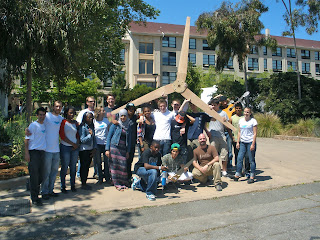This village, despite having only 400 inhabitants, is very dynamic, sporting a cyber cafe, an elementary school and several factories where some of the famous bottles of luxurious French perfumes are produced.
The village is led by Colette Michaux, the energetic mayor. Together with the Water Agency of the region (Agence de l’Eau Artois Picardie) she offered to fund one of blueEnergy’s water projects. The objective is to build 25 wells, 75 water filters and 20 latrines to provide 75 families of Bluefields with clean water and sanitation.
The Water Agency of Artois Picardie funds projects in several countries, but this will be the first time that they will take part in a project in Latin America. Concerning the village of Liomer, they have had an educational project in Mali and are interested in expanding to work with other regions of the world.
Benoit and Emilie met with Mrs Michaux and Arnaud Courtecuisse, head of the International Department of the Water Agency. Both Mr. Courtecuisse and Ms. Michaux are considering taking part in the Seminary of French decentralized cooperation, to be held in Esteli, Nicaragua, in November. blueEnergy is taking an active part in the organization of this event, coordinated by the French Ambassy of Nicaragua.
 |
| Benoit and Emilie meeting with Colette Michaux, mayor of Liomer, and Arnaud Courtecuisse, head of the International Department of Artois Picardie's Water Agency |
During the afternoon, Benoit and Emilie introduced more than 20 children of Liomer’s school to the challenges facing Nicaragua in regards to lack of clean water and energy access. The difficult part for the nine-year-old children was correctly spelling Nicaragua - it is a tough one and may show up on their next spelling test! The presentation aimed to grow the children's awareness of the world’s inequalities: even if they are lucky enough to have proper sanitation installation, easy access to clean water and energy, it is not the case for all the children in the world.
 |
| Emilie explains how we can create renewable energy with wind and sun |
The children were also introduced to the living conditions of the Caribbean coast of Nicaragua and had many questions and remarks. For many of them, it was the first time seeing houses on stilts or latrines built over rivers. It was hard for the children to imagine families drinking water from contaminated wells and having no way to properly dispose of or treat human waste. They also learned that nearly all transport along the coast is by boat; they were curious about blueEnergy biodigesters and the function of wind turbines. One aspect of life in Bluefields that is quite similar to that of the children is visits to the markets!
 |
| Benoit explains Nicaragua's geography while Helene Michel, teacher of the class, writes key work on the whiteboard |
The children's teacher, Hélène Michel, enjoyed the presentation: “...it was full of information for the students. We will continue to work on energy and water savings so that this presentation has an impact on Liomer children's lives.” Another way to foster intercultural exchanges between France and Nicaragua will be to build a partnership between Liomer and Bluefields students. Liomer students are ready for this collaboration, and they hope to hear soon from their Nicaraguan fellows!













